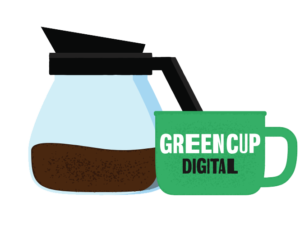Have you ever landed on a website and thought, What am I even doing here? Your website content is the deciding factor in whether visitors stay or bounce. It’s like going on a blind date, taking one look, and sneaking out the back door before they even notice you.
Yikes. No one wants their website to be the guy sitting alone at the table wondering what happened (seriously; quick bounce rates will kill your search engine optimization (SEO)).
Here’s the hard truth: you have just 1-2 seconds to make a first impression. If your website content isn’t clear, engaging, and purposeful, your potential customer will bounce—and they’re not coming back.
If you’ve been stressing about how to turn that first impression into a lasting relationship, don’t worry. Read on for four easy and actionable tips to help you craft content that grabs your visitor’s attention, keeps them engaged, and ultimately drives them to take action.
Website Content Tip #1: Write Engaging Headlines and Taglines
Headlines do more than grab attention—they also play a critical role in user experience and SEO. A clear, benefit-driven headline can help your page rank higher in search results, making it easier for your audience to find you. In other words, a solid headline is both flashy and functional.
The Power of First Impressions
The headline is often the first thing your visitors notice and engage with on your website. During this critical first impression, you want to be exactly what they’re looking for. To do that, you should write a headline that solves your visitor’s main problem and drives them to take action in just a few words.
How to Craft Irresistible Headlines
- Use clear, benefit-driven language: What’s the tangible outcome they will get from clicking the button, working with you, etc.?
- Keep it short and to the point: Aim for 6-8 words that pack a punch.
- Be specific: Vague promises don’t work. Provide concrete, clear outcomes.
Example: We’ll make sure [target customers] always have the best [product]. Get yours here.
Website Content Tip #2: Focus on Benefits, Not Features
Many businesses make the mistake of focusing on what their product or service does rather than why their customer needs it. Customers don’t care about features. They care about how your product or service improves their lives. This is the benefit–and this is what you need to show them.
Features Tell; Benefits Sell
Feature: What your product does.
Benefit: How it makes your customer’s life better.
Your audience wants solutions to their problems, not a list of specs. If you want to convert your visitors to customers, you have to show them how your product or service solves their problems. Frame your content to answer their unspoken question: “How does this make my life easier, better, or more enjoyable?”
Remember, customers aren’t buying your product; they’re buying what your product will do for them. Check out this example of how to turn a feature into a benefit:
Feature: Our SUV has all-wheel drive.
Benefit: Standard all-wheel drive ensures safety in all weather, giving you peace of mind that your loved ones are protected.
Benefits tap into emotions, and emotions drive decisions.
Communicate Clear Value
When you highlight benefits, be sure to focus on both emotional and practical value. Use phrases like “save time,” “make life easier,” or “maximize efficiency” to demonstrate how your product just makes sense for them.
- Practical Benefits: “Save 5 hours a week with our automated tool.”
- Emotional Benefits: “Feel confident and stress-free knowing your finances are in order.”
Website Content Tip #3: Use Clear, Persuasive Calls-to-Action (CTAs)
CTAs: The Bridge to Action
A Call-to-Action (CTA) is the most critical piece of content on your page. Without it, even the best content falls flat. Your CTA must tell readers exactly what to do next—and make them want to do it.
Example: “Sign up now and get 20% off your first purchase!”
Keys to an Effective CTA
- Be action-oriented: Use strong verbs like Get Started, Download Now, or Book Your Call.
- Add urgency or exclusivity when appropriate: Give a reason to act now (e.g., “Sign up today to get 20% off your first purchase!”).
- Make it clear and compelling: Don’t assume your prospective customer knows what to do next. Removing the guesswork ensures a clear path to action.
CTA Placement Matters!
To further guarantee that clear path, make sure CTAs are everywhere your visitor is. Don’t make them search for where to make a purchase or sign up for your list. Put it in plain sight. Easy access.
Here are some great places to put CTAs on your website:
- At the top to capture quick decision-makers.
- In the middle to re-engage readers who skim.
- At the end to convert those who need more convincing.
Website Content Tip #4: Keep Content Scannable
Most people don’t read websites word-for-word—they scan. Walls of text overwhelm visitors, while scannable content makes it easier for them to digest the information. It also makes it easier for them to find what they’re looking for, which usually translates to them spending more time on your page (another SEO win).
How to Make website Content Easy to Read
- Break it up: Use short paragraphs (2-3 sentences) and white space.
- Use bullet points and lists: Highlight key takeaways quickly.
- Guide with headings and subheadings: Make your content easy to navigate.
Highlight the Good Stuff
Draw attention to critical information with bold text, italics, or call-out boxes:
Example: “Save time and money—two resources you can’t afford to waste.”
Bonus Website Content Tips
Tell a Story
Facts are great, but stories are memorable. Whether it’s a customer success story or the journey behind your business, a compelling narrative builds trust and connection.
Optimize for SEO
Make sure your content gets seen by:
- Including keywords in headlines, meta descriptions, and headings.
- Optimizing images with alt text.
- Linking internally to other relevant pages.
Keep It Polished
Good content is clear and error-free:
- Read your work out loud to spot clunky sentences.
- Use tools like Grammarly for extra polish.
Website Content Tips Conclusion
Writing website content that converts is about clarity, strategy, and empathy for your audience.
Don’t let your next customer be the one that got away. Remember to make a strong first impression, keep the conversation engaging, and leave them wanting to come back for more. Follow these tips, and you’re sure to turn your next visitor into a lasting connection.
Not sure where to start? At GreenCup Digital, we specialize in creating strategic, engaging content tailored to your audience’s needs. Let us help you write content that turns visitors into loyal customers.
Contact us today to boost your website’s performance and take your business to the next level!






